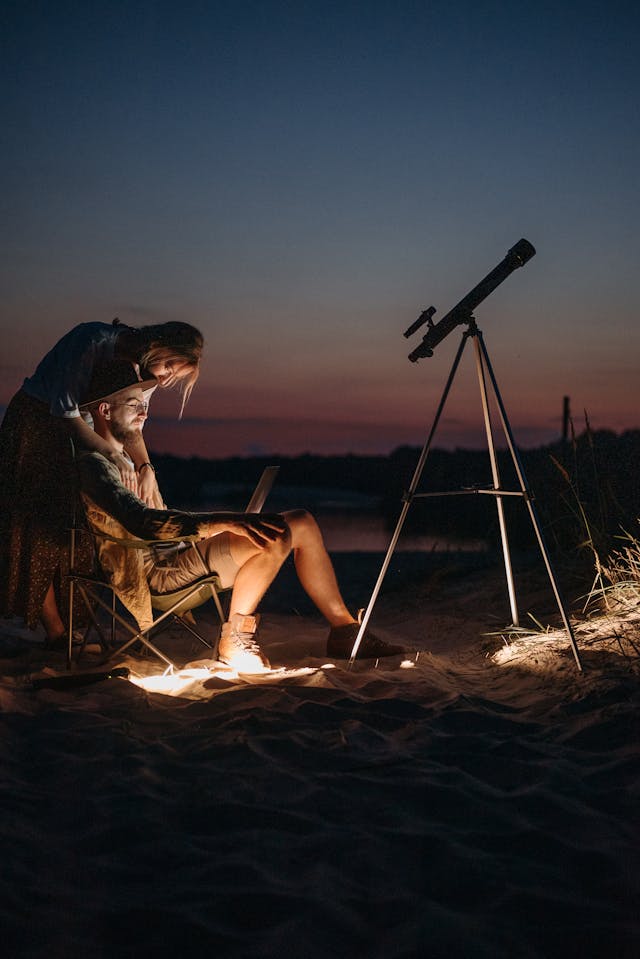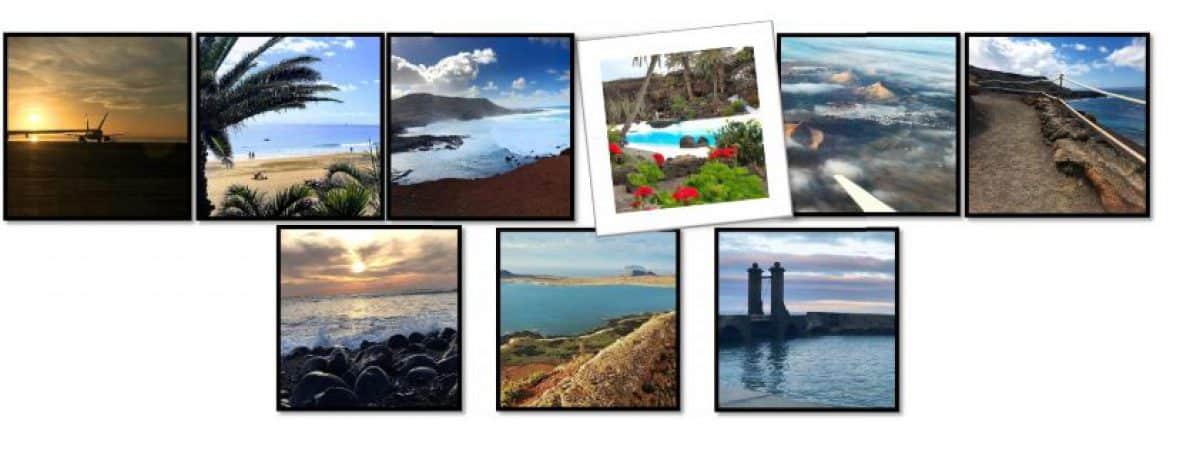This post is also available in:  Español (Spanish)
Español (Spanish)
Lanzarote is an incredible destination in many respects. Its beaches, paradisiacal landscapes, and spaces full of culture and traditions make the island a place everyone wants to visit. In addition to all its natural virtues, there you can enjoy an amazing astronomical experience with StarGazing in Lanzarote. This guide brings you everything you need to know, so that stars and constellations can be part of your itinerary.
Why Lanzarote is an Ideal Destination for Amateur Astronomers
The night sky in Lanzarote is characterised by its deep darkness, and this is due to several reasons. One is the island’s remote location, another is its low population, and there’s also no light pollution.
Moreover, the island’s warm, dry climate all year round means rainy days are rare, and clear nights predominate.
Its favourable geographic location, at around 29°N, provides a privileged view of Northern Hemisphere constellations such as Orion, Leo, or the Great Bear, as well as certain celestial objects close to the celestial equator, including the galactic centre of the Milky Way, especially visible during summer.
Furthermore, its position in the Atlantic Ocean, far from large continental land masses, reduces interference from atmospheric dust and pollution.
All this means Lanzarote nights offer remarkable clarity for admiring the stars in all their splendour. And that’s why it has become a perfect destination for amateur astronomers.
The Best Places to Observe the Stars in Lanzarote
In Lanzarote, you can take routes and walks to observe the stars on your own, so we’ll tell you which are the most recommended sites, so you can star planning your trip.
Mirador Astronómico Peñas del Chache
Located north of Haría, it is the highest point in Lanzarote. It is 670 metres above sea level. You can reach this viewpoint with your private car, as it is easily accessible and also has a parking area for vehicles.
For a doubly amazing experience, you can approach the viewpoint before the sun sets, and take the opportunity to admire a dreamy sunset on Lanzarote, and wait for the stars, constellations, and the moon itself to gradually begin to appear.
Timanfaya National Park
Another place to look at the stars in Lanzarote is Timanfaya National Park. Its distant location and the absence of artificial light allow the sky to be appreciated with total clarity.
This, in combination with the volcanic landscape of the park, the craters, and the rocks, creates a visual contrast that makes the experience even more wonderful.
Beaches and Coasts Away from Artificial Light
The beaches and coasts farthest from the tourist centres allow you to see the spectacular night sky of Lanzarote, thanks to the low light pollution.
In the north of the island, you have beaches like Famara. There, its golden sands and panoramic view make this place the perfect spot to enjoy a starry night.
In the south, you find Playa Papagayo and Playa de las Conchas, the first with its crystal-clear waters and white sand becomes the perfect setting for a magical night lying on the sand watching the stars. The second is a less visited area, with calm waters, ideal for being relaxed.
If you are staying in the south, book a cheap transfer from Lanzarote airport to Puerto del Carmen.
Inland areas
In Lanzarote’s interior regions, such as around Teguise or the wine-producing region of La Geria, there is less artificial lighting than in coastal tourist areas. Thus, these open landscapes provide broader night sky views.
For optimal stargazing in these interior areas, find open terrain away from main roads. La Geria offers several excellent spots for a night-time experience.
Tinajo area
The area surrounding Tinajo consists of remote lava fields and volcanoes with minimal light interference, making it perfect for stargazing.
Look for elevated spots for the best views, and avoid particularly windy nights. Be aware that accessing certain areas may require a 4×4 vehicle.
Necessary Equipment for Star Observation
The Basics: What to Bring to a Night of Observation
Enjoying a night observing the stars does not require much preparation. To start, remember to bring warm clothing, at least a light jacket as the temperature can drop at night, even in summer.
Additionally, if you have equipment like binoculars, a telescope, or a camera, don’t forget to bring them. They will help you see the sky better and preserve incredible memories.
Download mobile apps such as Stellarium or SkySafari to help identify constellations, enhancing your experience.

Tips for Using Your Telescope or Binoculars
- Take time beforehand to review the manufacturer’s instructions for your binoculars or telescope, so you can make the best use of them.
- Check the area, and find a comfortable space where you have a clear view of the sky without interference.
- Make sure the telescope is properly placed and levelled on the ground.
- Adjust the focus of your binoculars or telescopes so you can observe everything more sharply.
- Be patient to fully appreciate the stars.
- Inform yourself about local regulations before visiting stargazing locations in Lanzarote, as some protected areas may have restrictions on night-time access.
Best Times for Star Observation in Lanzarote
Although Lanzarote offers great stargazing conditions all year round, summer (June–August) provides warmer temperatures and clearer views of the Milky Way, while winter (December–February) is ideal for viewing constellations such as Orion.
Understanding Weather Conditions
The climate in Lanzarote throughout the year, with little rain, clear skies, and an average annual temperature of 22 degrees Celsius, weather conditions that make any day you visit the island a good day to admire the stars.
But if you want to know the best time, the warm, dry climate with clear nights prevails from spring to autumn.
Also remember that when there is a new moon, there is more darkness, and therefore, the stars are better seen. You can check the lunar calendar before organising your astronomy outing.
Astronomical Events Throughout the Year
Almost every month, you can see meteor showers in the Lanzarote sky. Some of the most famous are the Perseid meteor shower, which can be observed in August.
In October, the Orionids appear, associated with the remnants of Halley’s comet.
In November, you can visit Lanzarote, and seize the chance to see the Leonids, a red-hued meteor shower with a green-toned trail.
While in December, the meteor shower, known as the Geminids, whose origin comes from an asteroid and travels at high speed.
In 2025, Lanzarote will be especially well-positioned for astronomical events such as:
- Total lunar eclipses (14 March and 7 September).
- Planetary alignments (21 January, 28 February, 11 August).
- Meteor showers (Quadrantids, Perseids, Geminids, among others).
- Supermoons (5 November, 5 December).
- Opposition of Mars (16 January), perfect for telescopic observation.
Plan your stargazing trip well. Don’t leave out any details and book� transfer from Lanzarote airport to Costa Teguise.
Tips for an Unforgettable Experience
Some tips to enjoy the fullest of your stargazing in Lanzarote trip:
- Plan your trip according to weather reports, to ensure that there are clear skies.
- If you want to enjoy some of the astronomical events we mentioned earlier, find out on which dates they are most clearly observed, and organize your trip based on this.
- Choose well the place from where you will see the starry sky.
- Have patience, and at the beginning let your eyes get used to the darkness, so that later you can better admire the sky and all the astronomical phenomena.
Conclusion
If you’re an astronomy enthusiast, or simply captivated by the stars, when you visit Lanzarote, don’t miss the opportunity to admire them in a wonderful setting that will dazzle you.
Remember to plan your visit in advance, so you can fully enjoy the star gazing experience in Lanzarote and keep the best memories.
And book tours in Lanzarote to explore the island with expert guides.
This post is also available in:  Español (Spanish)
Español (Spanish)

